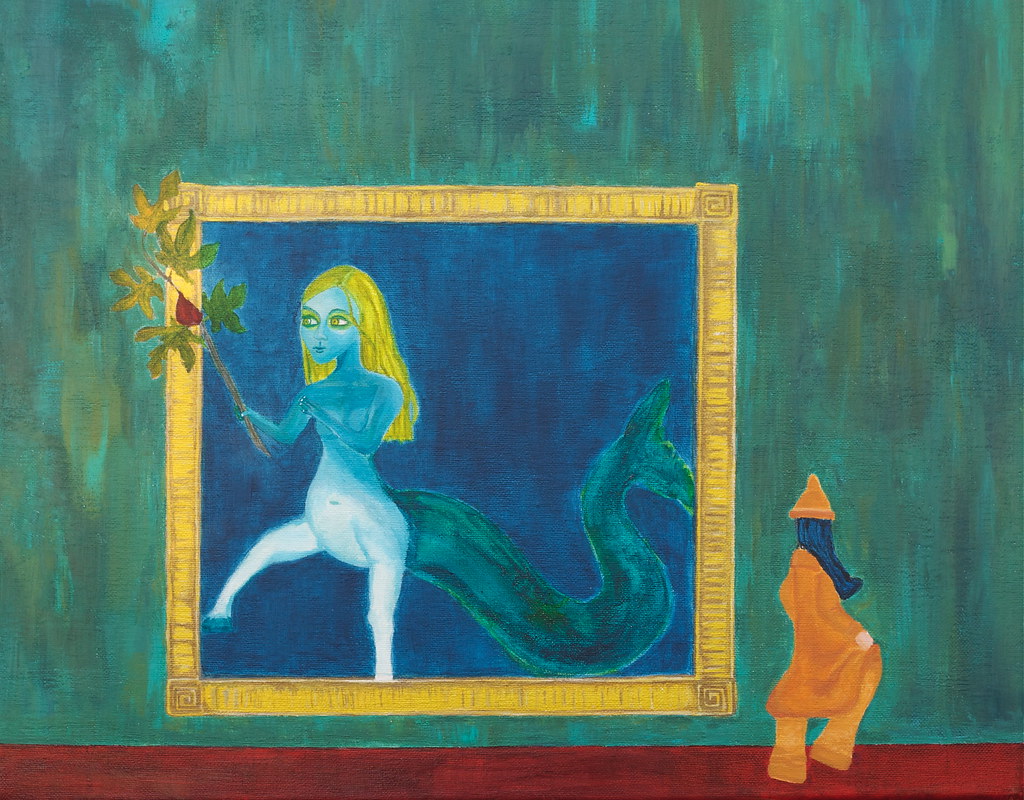
(the frame is gold leaf and shiny:)
This painting began as an exploration of a segment from Borges' Book of Imaginary Beings, in which he described a curse created by "The Yellow Emperor" which kept a whole other world confined inside the reflective surfaces of our own world, and how one day that curse would be broken. When I was making the drawing for it, I was thinking of humans, of us being the ones trapped inside the mirrors--trapped by perceptions of the world and its possibilities that we'd developed before we were even conscious of what we were doing, perceptions handed down to us by our parents, society, ill-managed emotions, fears, etc. I was thinking about it in the sense of our "true selves" being something completely foreign, even unrecognizable to this somnolent being that wanders through each day, making often meaningless, rote motions at dictated times (coffee, job, study, gym, drive, pick up the kids, whatever your life is, etc) in an effort to pass "correctly" or safely through yet another day. To make it. My thinking was that most of the time, our perception of what is possible is limited to what we've already seen done; thus, most of the time, we're merely mimicking--mirroring--what is already before us, unable to believe past what we can see and into the wild, chaotic space beyond it. So this moment of freedom from the curse would be that moment of passing through the mirror, becoming (once more) real, alive.
Or, in quantum physics, it is said that all the possible outcomes of the choices that we're faced with at each moment are played out in some space and time, and each of those spaces and times are called parallel realities. Sometimes these realities are symbolized as bubbles jostling each other in endless space. The mirror, then, might be the thin skein of the bubble separating one reality from another. One choice from another. One me (one you) from another.
After I made the drawing, but was still unsatisfied with my understanding of the passage, I stumbled upon the story of St. Rita, and I found in her the woman, the human part of the spirit here painted breaking out from her illusory prison and into a new world. This creature is St. Rita, leading us directly into the impossible.
The Italian St. Rita, as is usually the case with the saints, greatly desired to join a convent as a young child, but was prevented. In obedience to her parents, at 12 years old she married, and bore her violent and otherwise criminally-inclined husband two sons. He beat her continually and otherwise brought her not much happiness, but she stayed with him, and towards the end of his life even managed to convert him to Catholicism and a new path. This was one of the first steps towards what she would become: the patron saint of impossible dreams and lost causes--and abused women.
Shortly after his conversion, her husband was ambushed and killed, and Rita was forced to channel her energies towards protecting the souls of her sons, who wanted to avenge their father's death. She prayed that God not allow their souls to be sullied by such an act as murder, and they instead died within the year. At that point, she returned to her attempts to join a convent, but was refused, several times, because of her status as widow and mother (as opposed to virgin, the requirement for a bride of Christ).
However, she persevered, and one morning, the good nuns awoke to find that she had been spirited into the locked convent in the middle of the night by her own patron saints. Feeling they could not ignore such a clear statement from God, they permitted her to stay.
Later, on her death bed in the convent, she made another impertinent request. She asked that a visitor bring her a fig and a rose from a garden she had always loved. The problem, of course, was that it was the dead of winter, and there would be no figs and no roses.
But, of course, there were. The visitor went to the garden she'd named, and found there just the fig and just the rose, and brought them to Rita.
So here, instead of the olive branch, St. Rita holds out the fig branch: her offering of the impossible, made so by dreaming it was so.. The fig branch is the first object to pass through the mirror, her dreams and desires leading her out into a new reality.
I had wanted a hybrid creature of some sort, as it would be one of "us" becoming something we had not before recognized as possible or real. Typically female (me first! :)), she is part fish because Borges said the first to escape the prison would be the fish: maybe because of the image of the fish growing legs and departing from the sea to begin the next stages of its evolution (towards humanity?), maybe because of the image of primordial chaos as a kind of sea that the first forms of organized life came out of, maybe because a fish first appears in your vision as a flash, a line of color, and only afterwards as a full being.
And then I thought she would need land-legs, and powerful ones, made for galloping.
And speaking of passing to the other side, or passing between worlds, according to Ursula Bielski, in her book Chicago Haunts: Ghostlore of the Windy City:













Wonderful, amazing post in every possible sense... the imagery, the colors (I love that blue background!), the symbols you have grasped in this furiously beautiful painting! And the story of St. Rita touches me deeply, as usually do the extraordinary lives of saints, lived in the twilight zone of the real and the supernatural. Congratulations, my dearest!!
ReplyDelete